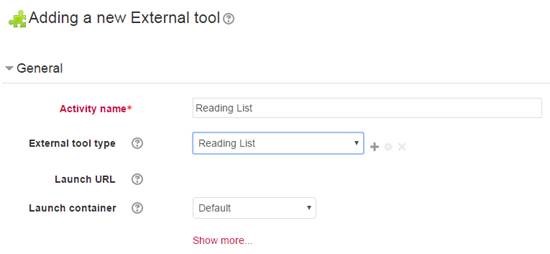
Simply go to Reading Lists and click on New List. See the rest of this guide for more information on creating and editing the perfect Reading List. NB: Check first to see if a list already exists for the module!
Importantly, remember to click on Reading List Options and select Send to Library when you are finished. Otherwise, the Library will not know to process your Reading List.
Associate your Reading List with the module code to ensure that it is visible to the right student group. To do this, select Course association options from the Reading List menu and click on Associate this list with a course.
Please note: you can only associate a module running in the current academic year. If you don't yet have a code for your module (before it has been approved, for example) then you can skip this step and publish your Reading List. Please remember to come back and associate your Reading List once your module is approved.
Publishing your list once you have finished putting it together ensures that the Library can action any purchases or digitisation requests. It also means that students will be able to see the contents of the list.
The two options below will allow you to provide access to the Leganto Reading List for your students in Moodle

Click the "Customisation in Moodle" tab on the right above for instructions on how to do this.

Pick up the URL (permalink) from your reading list in Leganto. To do this, select "Create a shareable link" and "To list" from the Reading List options menu (the three horizontal dots on the top right of the page).

Paste the permalink into the appropriate section in your module descriptor. You only need to do this once. Amending your reading list in Leganto does not alter the permalink URL.
Option One: Set up your reading list starting at Moodle
This will mean that your reading list will be shown in your Moodle module, and automatically associated with your chosen module.

Option Two: Create your new reading list in Leganto
You can also set up reading lists starting at Leganto.
This means you can create your reading list, and link to it from Moodle when you are ready to publish it.
Notes
You can only link reading lists to Moodle modules that are running in the academic year.
If you want other teachers to be able to edit the reading list (or see it before it is published), you will need to add them as collaborators.
In your reading list, click Manage Collaborators on the right hand side.
Reading Lists are divided up into Sections. Each section could be used for a new topic or week for example, or to separate a small Reading List into reading for lectures from readings for tutorials, for example. Each Section also comes with space for you to provide more information.
If you have created your reading list in Leganto, you can use the Reading List tool in Moodle to add a link to the Reading List associated with your module.
Link to a Leganto reading list from Moodle
Turn editing on and select Add an activity or resource in the section you would like the reading list to appear.
Select External tool and click OK.

Give the tool a name (Reading List is a good idea...) and select Reading List as the External tool type. Make sure to save your changes.
The reading list tool will rollover with your module when Moodle is refreshed for the new academic year.
See our one-page Help Guide: Linking with Moodle
You can also use this same tool to link to individual Sections, rather than a whole Reading List. The information needed for this can be copied by selecting LTI Direct Access, and copying the information to your clipboard.
As when linking to an entire Reading List, to do this, turn on editing in Moodle and select Add activity or resource, give the tool a name (Reading List is a good idea or you could use the name of the Section your are linking to...) and select Reading List as the External tool type. Then, under Show More, paste the LTI Direct Access code into the Custom Parameters text box. Don't forget to save your work.
See our one-page Help Guide: Linking to Sections
You can create a reading list for a new module seeking approval. Create your reading list in the usual way. If you don't have a module code, you can use the proposed module name. When the module is approved, you can add the module code to your reading list.
When finished, send it to Library for publication and paste the URL permalink into the module descriptor section about reading lists.
Pick up the URL (permalink) from your reading list in Leganto. To do this, select Create a Shareable Link from the Reading List options menu. Select To List. Paste the permalink into the appropriate section in your module descriptor. You only need to do this once. Amending your reading list in Leganto does not alter the permalink URL.
You will not be able to associate your reading list with your module until the module is approved. As such, although your list has been published, it will not yet appear on Moodle.